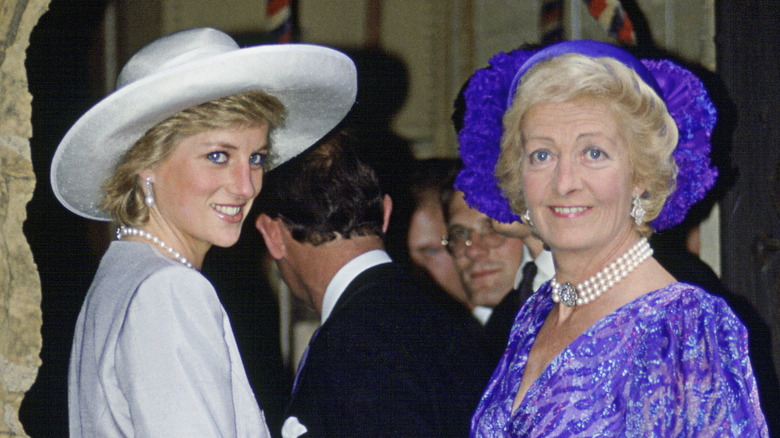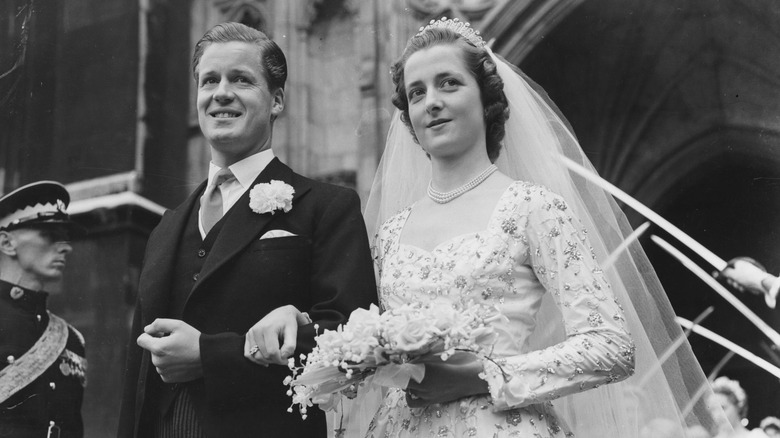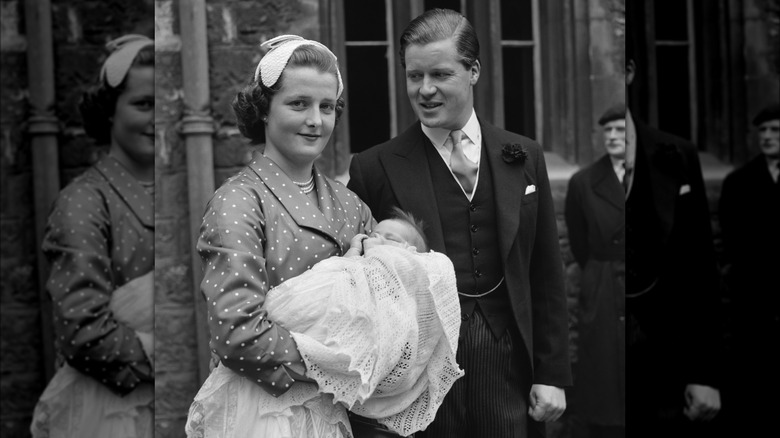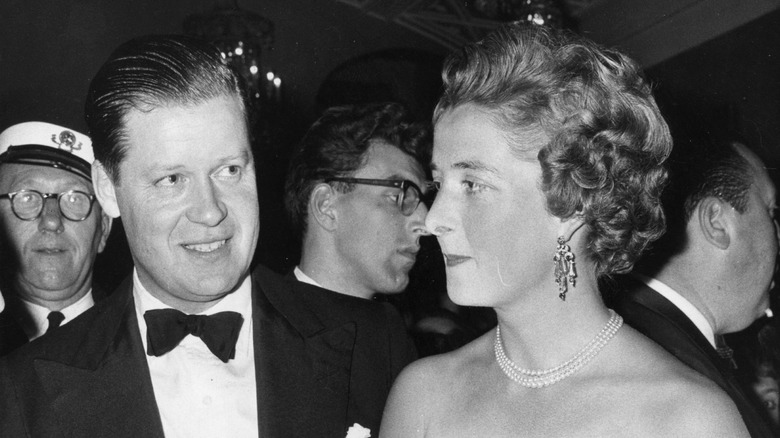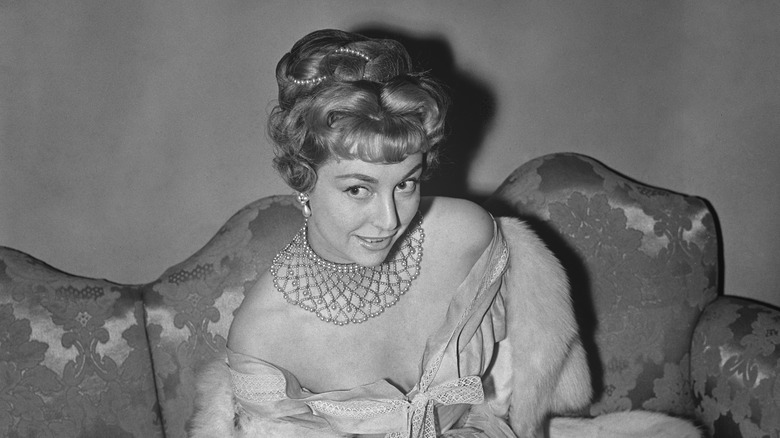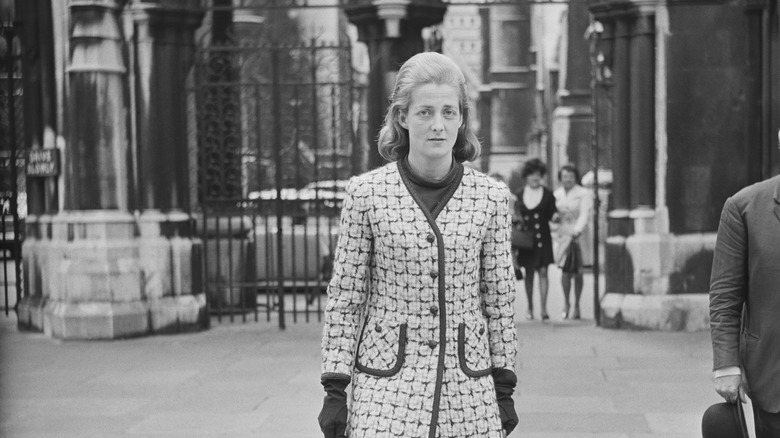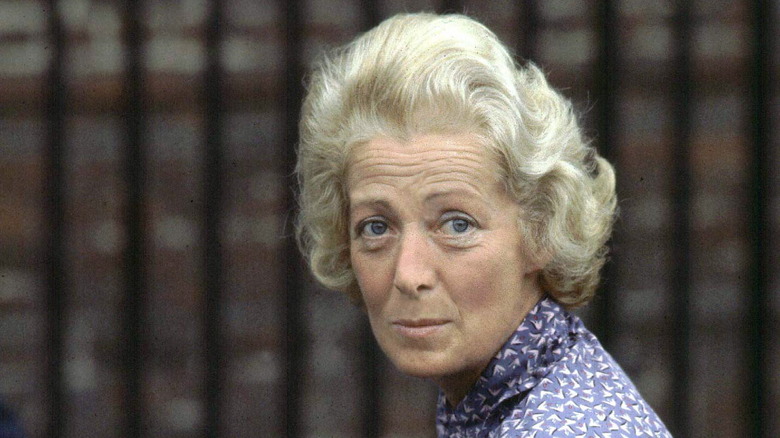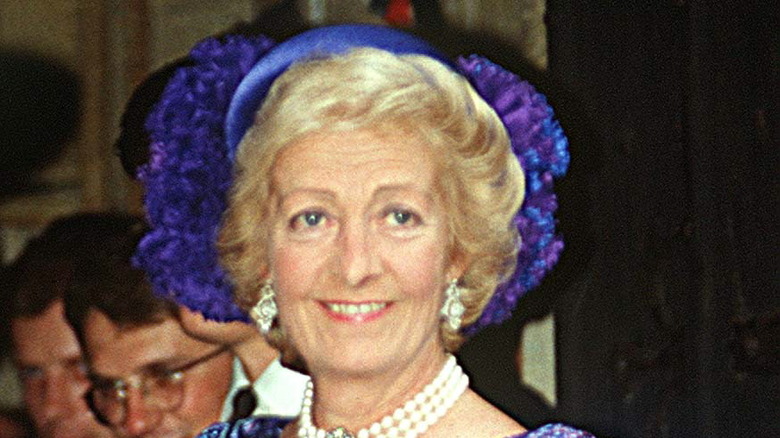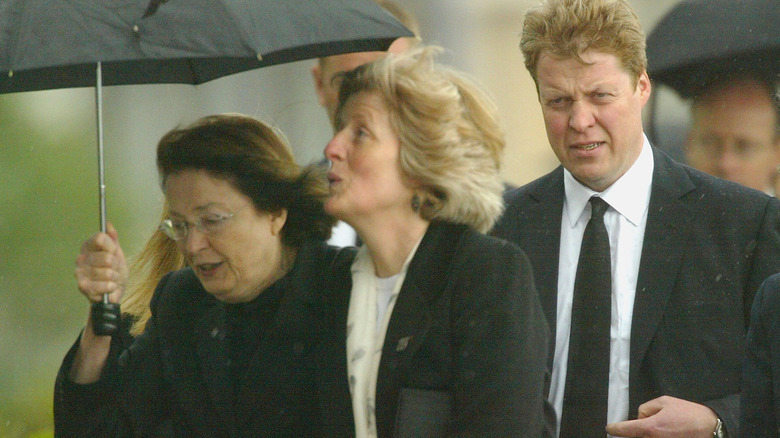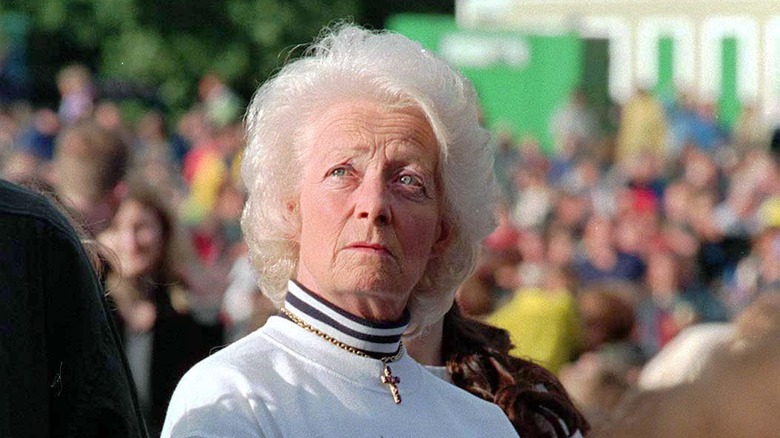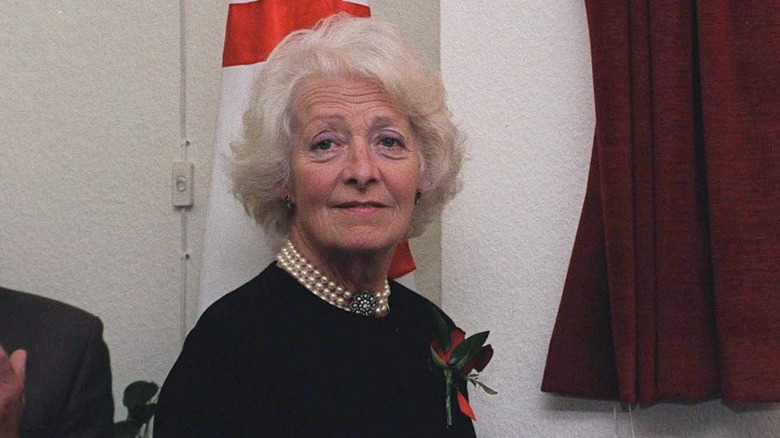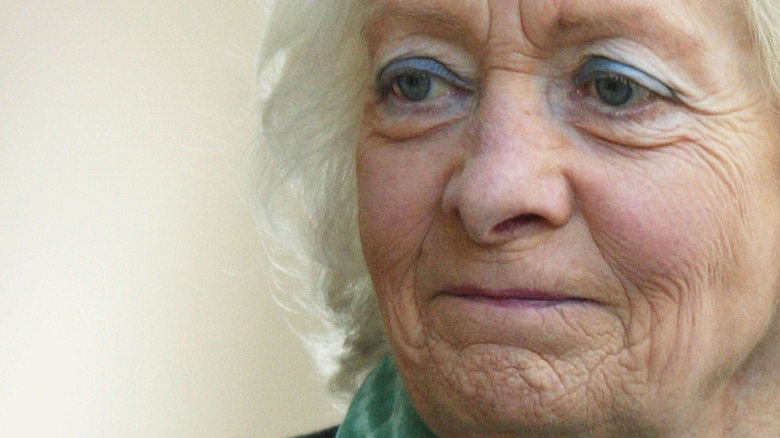The Tragic Truth Of Princess Diana's Mother, Frances Shand Kydd
As a high-born member of British society, Frances Shand Kydd had been in the spotlight since she was a teenager. However, she will always be best known as the mother of Princess Diana. While Shand Kydd was no princess herself, she was born with a noble pedigree: her father was Edmund Maurice Burke Roche, the 4th Baron Fermoy, who counted King George VI among his friends, while her mother was a close confidante of the king's wife, Queen Elizabeth, later known as the Queen Mother.
Born Frances Roche, she was just 18 when she married Diana's father, Edward John Spencer (who was then 30), in 1954. He was likewise an aristocrat, heir to the earldom of Spencer. The couple's wedding took place within Westminster Abbey, traditional site of the British royal family's most important ceremonies. As the BBC reported, the crème-de-la-crème of British high society was on hand to witness the nuptials — including Queen Elizabeth II herself — which was described as "one of the social events of the year." Also notable was the fact that the bride was the youngest woman to be married in that storied cathedral within the prior half-century.
Despite those auspicious beginnings, her life was one of heartbreak, pain, and betrayal — all of which played out in public, given that her daughter was one of the most famous people of the 20th century. To discover more, read on to explore the tragic truth of Princess Diana's mother, Frances Shand Kydd.
Her marriage to Diana's father was troubled and violent
Over the course of their marriage, Frances Shand Kydd and her husband bore five children. After marrying, she took on the birth title of her husband, the Viscount Althorp, becoming Viscountess Althorp. Eventually, her husband would become the 8th Earl Spencer, gaining the title that also came with Althorp, the vast ancestral estate that had been in the Spencer family for generations.
Despite that wealth and privilege, all accounts indicated that the marriage was not a happy one — a factor that contributed to Princess Diana's unhappy childhood. In the 2021 CNN docuseries, "Diana," Diana is heard in an audiotape describing a harrowing incident she witnessed when she was a young child. "I remember seeing my father slap my mother across the face and I was hiding behind the door and she was crying," Diana recalled (via Business Insider).
In that same series, author Penny Junor – a journalist and expert on the British monarchy who has written several books about the royals — confirmed Diana's account of witnessing domestic abuse. According to Junor, Diana's mother came to the conclusion that she needed to leave the marriage, for the sake of both herself and her children. "Johnny could be violent," Junor said. "And she felt she and her children would be safer out of the home."
If you or someone you know is dealing with domestic abuse, you can call the National Domestic Violence Hotline at 1−800−799−7233. You can also find more information, resources, and support at their website.
Her first son died shortly after his birth
Because of the Spencers' aristocratic origins, inheritances within the family were based upon primogeniture, in which the title of earl (and the associated homes and wealth that came with it) was inherited by the firstborn male. As a result, the primary marital function — in the eyes of the aristocracy — for Princess Diana's mother was to deliver a male heir.
Frances Shand Kydd became pregnant within months after the wedding. A year after the nuptials, she gave birth to a daughter, Elizabeth Sarah Lavinia. The couple tried again; Two years later, they welcomed a second child — once again a daughter, Cynthia Jane. Still having not produced an heir, in 1960, she finally bore a boy, a son named John. Tragically, there were complications at birth, and the baby died within hours of his birth due to a condition with his lungs.
Their next attempt at producing an heir was another strikeout when Diana was born in 1961. Even at a young age, Diana could feel the undercurrents of her parents' disappointment that she wasn't a boy. "I couldn't understand why I was perhaps a nuisance to have around," the late princess said in audio featured in CNN's "Diana" docuseries (via Business Insider). As Diana recalled, "the child before me died, and it was the son ... and heir. And then comes a third daughter. 'What a bore. We're going to have to try again.'" Finally, in 1964, the couple welcomed Charles Spencer, future 9th Earl Spencer.
Frances Shand Kydd wasn't cut out to be a mother
While Frances Shand Kydd was expected to focus on motherhood, she wasn't necessarily a natural at it. That was the observation of her youngest son, Charles, 9th Earl Spencer, who told the Sunday Times Magazine that motherhood was simply something that she wasn't suited for. "Our father was a quiet, constant source of love, but our mother wasn't cut out for maternity ... she couldn't do it," the youngest sibling said.
Meanwhile, during the course of the marriage, she had also grown distant from her husband. "We just drifted apart and there was nothing either of us could do about it," she once said, as reported by The Telegraph. In 1966, she met Peter Shand Kydd, heir to a wallpaper fortune, who was also married with children. "It wasn't love at first sight, but I do remember we made each other laugh," she recalled.
Eventually, they fell into an affair that left both their marriages in tatters and ruined her reputation. Looking back, she blamed the sorry state of her relationship with her husband for her infidelity. "If Johnnie and I had had a strong marriage, it wouldn't have happened," she said. Ultimately, she left her husband and children to continue her relationship with Peter. "She was in love with someone else, infatuated really," Spencer noted about his mother.
She was vilified in the press as a 'bolter'
During the 1960s, leaving one's husband for another man — particularly one who was also married, with children — was a shocking scandal among the British upper crust. As Julie Montagu, an American-born viscountess, explained in CNN's "Diana" docuseries, the repercussions experienced by Frances Shand Kydd were severe. "Diana's mother, in a very unhappy marriage, left, for very good reasons, and was shunned in society," Montagu said (via Business Insider).
When she and her first husband divorced, they fought a bitter court battle over custody of their children. To say it didn't go well for her is an understatement; her own mother testified against her in court, stating that she was an unfit mother. In the press, Shand Kydd was branded as a "bolter," a homewrecker, an adulterer, and the other woman. Meanwhile, Diana — who was just 6 years old – was left confused and devastated. "While she was packing her stuff to leave, she promised Diana she'd come back to see her," Diana's brother, the Earl Spencer, recalled in an interview with the Sunday Times Magazine. "Diana used to wait on the doorstep for her, but she never came."
When the dust settled, both she and Peter Shand Kydd divorced their respective spouses and got married in 1969. Yet this new chapter in her life would not have a happy ending.
She was separated from her children after losing a custody battle
After losing custody of her children to her ex-husband, Frances Shand Kydd and her new husband moved to Scotland, relocating to the small island of Seil. After enduring the harsh spotlight of the British press, living in the tiny community brought her privacy and peace. She ran a modest gift shop and reportedly lived a quiet life out of the public eye.
However, her new living situation in a remote part of Scotland also meant that she rarely saw her children. Writing in her diary (in an entry that was later published in the book "Frances: The Remarkable Story of Princess Diana's Mother"), she blamed lawyers for the estrangement from her children. "Johnnie and I would agree on an arrangement for the children, our respective lawyers would advise that this should be documented and, by the time they'd used their professional languages, a friendly agreement seemed to be complicated beyond all measure," she wrote, as excerpted by Vanity Fair. "And this would invariably result in an argument. Not surprisingly, it would then be the children who suffered."
In 1982, when the London Daily Express reported on an upcoming book that characterized Shand Kydd as having abandoned her children, she pushed back. "Mrs. Shand [Kydd] has been deeply hurt by some of the recent versions of those events, particularly the suggestion that she deserted her family," her rep argued to the Express (via UPI).
Her second husband left her for a younger woman
Frances Shand Kydd's quiet life of relative obscurity evaporated in 1980 when the future king of England began courting her youngest daughter, Diana. Suddenly, her teenage daughter was at the center of a media frenzy, something that Shand Kydd railed against in a 1980 letter she'd sent to The Times. However, Diana would ultimately credit her mother — who had managed to weather her own media scandal — for her ability to put on a brave face while she was crumbling inside.
"I've got what my mother has got," Diana once said, as reported by The Telegraph. "However bloody you are feeling, you can put on the most amazing show of happiness. My mother is an expert at that and I've picked it up. It kept the wolves from the door." The attention focused on Diana spilled over to her mother; In 1983, Shand Kydd was forced to sell her gift shop due to an endless parade of tourists asking her about her daughter.
Sadly, Shand Kydd faced another public humiliation when her second husband, Peter Shand Kydd, began an affair with a younger woman, French champagne expert Marie-Pierre Palmer. In 1988, they announced their separation. Years later, she reflected on the end of her second marriage. "Peter and I drifted apart," she explained to the Daily Mail (via The Standard). "I thought if I tried hard enough we'd find calmer waters. Well, we didn't."
She was banned from driving after a drunk driving conviction
The years following her second divorce were particularly difficult ones for Princess Diana's mother, Frances Shand Kydd. Not only was she devastated to be abandoned by her husband after nearly 20 years of marriage, she was also watching her daughter's fairytale entry into Britain's royal family turn into a nightmare as Diana's marriage to then-Prince Charles imploded with one scandal after another, a slow-motion train wreck that she was powerless to stop.
In 1996, Shand Kydd — then 60 years old — was pulled over in Oban, Scotland on suspicion of driving under the influence. As Scotland's The Herald reported, she refused to submit to a breathalyzer, but testing indicated that her blood alcohol level was more than two-and-a-half times the legal limit. She was charged with drunk driving, but denied she was guilty. During the trial, which lasted for three days, Shand Kydd claimed she had received a letter on that particular day that had greatly upset her; While she didn't share details, she admitted to being so rattled that she calmed her nerves with a glass of wine. The arresting officer, however, testified that she was incoherent, and appeared to be "staggering" drunk.
Shand Kydd was ultimately found guilty, but the punishment was relatively minimal. She was issued a £400 fine and banned from driving for one year. As she left court, she succinctly told reporters, "I have nothing to say to anybody at any time.”
She wasn't on speaking terms with Diana when she died
Millions mourned when Princess Diana was killed in a tragic 1997 car wreck. Yet none of them experienced what Frances Shand Kydd went through, the anguish of losing a child. As sad as that situation was, it was made even more so when Shand Kydd revealed that she and Diana had been estranged at the time.
A few years after Diana's death, Shand Kydd was called to testify at the trial of her daughter's one-time butler, Paul Burrell, who was accused of stealing Diana's private items and selling them to the press. During her testimony, she confirmed that there was a rift between mother and daughter, and that she and Diana hadn't spoken for four months prior to her death. "Every family has these disagreements and disputes, [which are] irrelevant to the future," she said, as reported at the time by The Independent.
While Shand Kydd didn't elaborate on why they weren't on speaking terms, Burrell resurfaced in 2008 — after Shand Kydd had died in 2004 — to claim Diana's relationship with Dodi Fayed was the cause of the quarrel. As Reuters reported, the former butler alleged that Diana had asked him to listen in while she spoke with her mother on the phone, claiming Shand Kydd "called the princess a whore and she said that she was messing around with f***ing Muslim men and she was disgraceful and said some very nasty things."
Her home was burglarized while she testified at the butler's trial
While Frances Shand Kydd took the stand to testify at Paul Burrell's 2002 trial, her home on the Scottish island of Seil was targeted by thieves. BBC News reported that while she was in London for the trial, Shand Kydd's housekeeper discovered evidence that someone had broken into the home, which had been torn apart by the burglars as they searched for valuables.
"While I was away giving evidence my house was burgled and all my jewelry taken. Everything," Shand Kydd told BBC News, revealing that the heist appeared to be the work of pros who knew what they were doing. "The wires of the phone were cut," she said. "And the security system."
According to Shand Kydd, personal items relating to Princess Diana hadn't been taken, but most of her jewelry was gone. "It included items of value and, more importantly, sentimental value, pieces which belonged to my grandparents and a ring given to me by my father," she added. "They went through the entire house ... They were professionals looking for jewelry, which they took."
She experienced debilitating health woes in her later years
The regret that Frances Shand Kydd felt over her fractured relationship with Princess Diana at the time of her death lingered in the years that followed. "Sometimes I think the only one resting in peace is Diana," she once mused, reported The Scotsman.
After testifying at Paul Burrell's 2002 trial, Shand Kydd retreated back to her remote home in Scotland. Having converted to Catholicism in 1994, she focused on devoting her efforts to helping others, including caring for disabled people, and organizing fundraising efforts for the families of those who died in the Lockerbie plane crash. As a local told the Daily Mail, there were other reasons beyond altruism that drove her charitable efforts. "She needs it for many reasons," one of Shand Kydd's Catholic acquaintances told the newspaper. "But most of all she needs it because it gives her a feeling of not being alone any more."
By 2004, her health had taken a downturn. As the Daily Mail reported in April 2004, she had been diagnosed with an unspecified brain disease that had severely impacted her ability to both walk and speak. She confronted her failing health in the same stiff-upper-lip sensibility she had demonstrated during her other public travails. "I have to confront and accept the limitations of the condition I have," she noted to the Mail. "It took a while to diagnose but I feel it is my business to keep to myself."
Her final years were sad and lonely
Frances Shand Kydd's brain ailment had left her significantly impaired. When speaking, her speech had become slurred, and she required a wheelchair. "She doesn't get out much at all," a Seil local told the Daily Mail. "We rarely see her these days, since she became worse. She would pop down to her local pub, but I haven't seen her for ages." Her self-imposed seclusion, however, had been apparent for some time; The Daily Mail referenced a somewhat mean joke making the rounds in Seil, that the burglar who broke into her home was "the first visitor she has had for ages."
Meanwhile, Shand Kydd had also been targeted by mentally unstable stalkers, including a Norwegian man claiming to be Princess Diana's father. The publication also reported that police were contacted after a disturbing note had been shoved under her front door, reading, "'I am here. I am coming here.'" Still, she tried not to dwell on the negative, despite all the tragedy she had endured. "I think I've had a wonderful life," she told the Mail, adding, "Certainly, there have been lows ... I think sadness only makes you more realistic about what life is."
Two months after that interview, on the morning of June 3, 2004 she died. According to her BBC News obituary, she had been hospitalized after falling. Her son, Earl Spencer, issued a statement through his spokesperson: "I can confirm that Lord Spencer's mother passed away peacefully this morning after suffering from a long illness."

